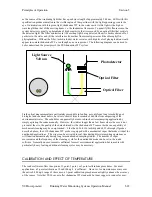
Principles of Operation
Section 5
YSI Incorporated Drinking Water Monitoring Systems Operation Manual
5-16
of chlorophyll, and thus phytoplankton, since the collection of samples at reasonable time intervals, e.g.,
every hour, would be extremely tedious.
YSI has developed the YSI 6025 chlorophyll sensor for the determination of chlorophyll in spot sampling
and continuous monitoring applications. It is based on an alternative method for the measurement of
chlorophyll which overcomes these disadvantages, albeit with the potential loss of accuracy. In this
procedure, chlorophyll is determined
in vivo,
i.e., without disrupting the cells as in the extractive analysis.
The YSI 6025 chlorophyll sensor is designed for these
in vivo
applications and its use allows the facile
collection of large quantities of chlorophyll data in either spot sampling or continuous monitoring
applications. It is important to remember, however, that the results of
in vivo
analysis will not be as
accurate as those from the certified extractive analysis procedure.
The limitations of the
in vivo
method are outlined below and should be carefully considered before making
chlorophyll determinations with your YSI sonde and sensor. Some of the sources of inaccuracy can be
minimized by combining the data from the YSI 6025 with data from extractive analysis of a few samples
acquired during a sampling or monitoring study. However, the
in vivo
studies will never replace the
standard procedure. Rather, the estimates of chlorophyll concentration from the easy-to-use YSI
chlorophyll system are designed to complement the more accurate (but more difficult to obtain) results
from more traditional methods of chlorophyll determination.
MEASUREMENT OF CHLOROPHYLL
IN VIVO
One key characteristic of chlorophyll is that it fluoresces, that is, when irradiated with light of a particular
wavelength, it emits light of a higher wavelength (or lower energy). The ability of chlorophyll to fluoresce
is the basis for all commercial fluorometers capable of measuring the analyte
in vivo
. Fluorometers of this
type have been in use for some time. These instruments induce chlorophyll to fluoresce by shining a beam
of light of the proper wavelength into the sample, and then measuring the higher wavelength light which is
emitted as a result of the fluorescence process. Most chlorophyll systems use a light emitting diode (LED)
as the source of the irradiating light that has a peak wavelength of approximately 470 nm. LEDs with this
specification produce radiation in the visible region of the spectrum with the light appearing blue to the
eye. On irradiation with this blue light, chlorophyll resident in whole cells emits light in the 650-700 nm
region of the spectrum. To quantify the fluorescence the system detector is usually a photodiode of high
sensitivity that is screened by an optical filter that restricts the detected light. The filter prevents the 470 nm
exciting light from being detected when it is backscattered off of particles in the water. Without the filter,
turbid (cloudy) water would appear to contain fluorescent phytoplankton, even though none were present.
The following diagram can be used to better understand the principles of the YSI system.
Содержание 600DW-B
Страница 3: ......
Страница 239: ...Principles of Operation Section 5 YSI Incorporated Drinking Water Monitoring Systems Operation Manual 5 26...
Страница 251: ...Warranty and Service Information Section 8 YSI Incorporated Drinking Water Monitoring Systems Operations Manual 8 4...
Страница 259: ...Required Notice Appendix B YSI Incorporated Drinking Water Monitoring Systems Operations Manual B 2...
Страница 264: ...EMC Performance Appendix D YSI Incorporated Drinking Water Monitoring Systems Operations Manual D 2...
Страница 268: ...Specifications Appendix E YSI Incorporated Drinking Water Monitoring Systems Operations Manual E 4...
Страница 297: ......
















































